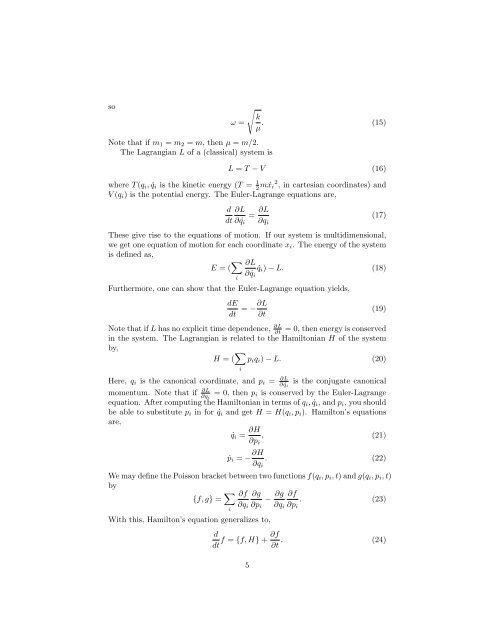Notes for the Physics GRE - Harvard University Department of Physics
Notes for the Physics GRE - Harvard University Department of Physics
Notes for the Physics GRE - Harvard University Department of Physics
You also want an ePaper? Increase the reach of your titles
YUMPU automatically turns print PDFs into web optimized ePapers that Google loves.
soω =Note that if m 1 = m 2 = m, <strong>the</strong>n µ = m/2.The Lagrangian L <strong>of</strong> a (classical) system is√kµ . (15)L = T − V (16)where T (q i , ˙q i is <strong>the</strong> kinetic energy (T = 1 2 mx˙i 2 , in cartesian coordinates) andV (q i ) is <strong>the</strong> potential energy. The Euler-Lagrange equations are,d ∂L= ∂L(17)dt ∂q˙i ∂q iThese give rise to <strong>the</strong> equations <strong>of</strong> motion. If our system is multidimensional,we get one equation <strong>of</strong> motion <strong>for</strong> each coordinate x i . The energy <strong>of</strong> <strong>the</strong> systemis defined as,E = ( ∑ ∂L˙q i ) − L. (18)∂ ˙qi iFur<strong>the</strong>rmore, one can show that <strong>the</strong> Euler-Lagrange equation yields,dEdt = −∂L ∂t(19)Note that if L has no explicit time dependence, ∂L∂t= 0, <strong>the</strong>n energy is conservedin <strong>the</strong> system. The Lagrangian is related to <strong>the</strong> Hamiltonian H <strong>of</strong> <strong>the</strong> systemby,H = ( ∑ p i q i ) − L. (20)iHere, q i is <strong>the</strong> canonical coordinate, and p i = ∂L∂q˙iis <strong>the</strong> conjugate canonicalmomentum. Note that if ∂L∂q i= 0, <strong>the</strong>n p i is conserved by <strong>the</strong> Euler-Lagrangeequation. After computing <strong>the</strong> Hamiltonian in terms <strong>of</strong> q i , ˙q i , and p i , you shouldbe able to substitute p i in <strong>for</strong> ˙q i and get H = H(q i , p i ). Hamilton’s equationsare,˙q i = ∂H , (21)∂p iṗ i = − ∂H∂q i. (22)We may define <strong>the</strong> Poisson bracket between two functions f(q i , p i , t) and g(q i , p i , t)by{f, g} = ∑ ∂f ∂g− ∂g ∂f. (23)∂qi i ∂p i ∂q i ∂p iWith this, Hamilton’s equation generalizes to,d∂ff = {f, H} +dt ∂t . (24)5
















